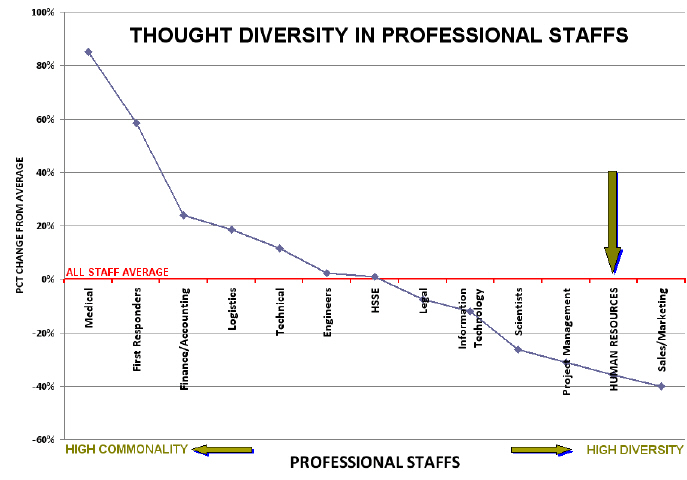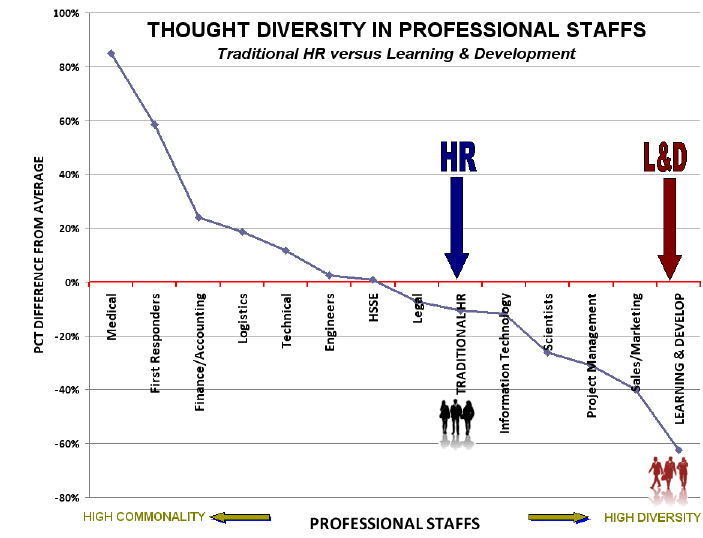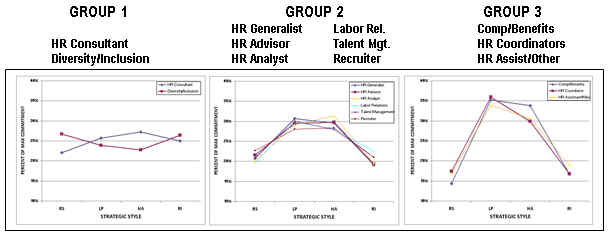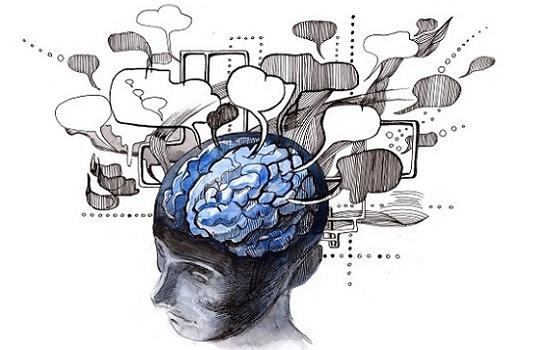We conducted a study on the thought diversity of 2,195 HR professionals. Thought diversity refers to the different ways a person can approach an issue. The perspective they use to approach the issue determines how they understand that issue and the possible range of their response to the issue. For example, a person focusing on the general aspects of an issue loses perspective on the particulars. Similarly, favoring immediate action prevents the issue being considered rationally and analytically. The specific mix of perspectives available in a group determines what that group can do and how it will do it.
Our technology is concerned with information processing. Information refers to what can be thought and how that thought will be processed, so we analyse in what ways business professionals approach issues and the complexity of the perspectives they take. In some business functions, there are a greater number of perspectives and this often comes down to the number and type of issues in that function.
Our recent survey found that HR professionals have one of the most demanding jobs when it comes to the number of perspectives taken within the function. One reason for this lies in HR’s raw material—the human being.
Humans are the most complex entity in the known universe. The materials of the engineer do not change their mind as they move from one product to another. The debits and credits of the accountants do not change relative position in the general ledger regardless of where or when they are viewed. The manufacturing production line is in the same place and moves in the same direction day after day. The raw material of HR has none of this built-in consistency. It is the only raw material that can change its mind.
Because of this, thought diversity is absolutely crucial in the HR function in order to deal with this constantly shifting variability and complexity.

HR also has another challenge from its mission, which has tenets that require very different approaches. One component of HR must conform to policies, labour laws and other restrictions that demand conformity and consistency. A very different part of HR must provide education and insight to disparate groups on a variety of subjects often of a nebulous nature. Meeting these dual and very different challenges requires that HR have available a staff whose thought diversity and variability reflects the constant shifting demands likely to be imposed.

What about L&D? Well, both the traditional HR and L&D departments are more thought diverse than average. This is testimony to the variable nature of the raw material – the human being. L&D is 62% more thought diverse than the average and is even higher than sales & marketing in its degree of thought diversity. Even traditional HR is 11% more thought diverse. This embedded thought diversity, and the need to funnel this into outcomes, is one source of the HR management challenge.
Thought diversity is not free. The way we look at an issue defines what we consider about the issue to be pertinent. Some people will look at a subject in detail, while others will focus on general aspects. Some will relate an item to previous experience and similar situations, others will view the subject in isolation. These frameworks determine how the issue is understood and processed. These and other such differences must be sorted out before action can be taken. Questions need answering: what’s the best way to look at the issue? Another management challenge.
Divergences in thought processes also carry cultural implications. Different processes create different expectations. A person focusing on action outcomes is likely to see tangible results as the criteria for gaining a reward. Another person whose focus is on thought is likely to view the depth of plans and assessments as the basis of reward. It’s results vs effort. This is a challenge at school and it’s no different in the working world. HR management must confront more of this built in variability than do other functions, and HR must set the example for the rest of the business.
Even the organization as a whole gets involved. With diversity comes unevenness. Variability can compromise efficiency as people ‘aren’t on the same page.’ Coordination between separate units, especially if they are geographically dispersed, becomes more difficult. The ability of outside staff to predict the behavior of other people gets harder the more diverse their thought processes and approaches are. The inability to accurately anticipate will give ample opportunity for negative judgements to be made. Of all the business functions, HR is the most likely to be “picked on” as a result. It is another “built in” challenge for an organization tasked with managing the people side of the business.
HR also confronts internal issues. Traditional HR and the L&D components are themselves variable. The thought diversity profiles of both HR components show considerable variability.


Each HR component appears to have at least three different general approaches. The consequences of this variability will play out when members of these different groups face common issues. The result can be a HR management headache.
One implication of the research is that thought diversity is necessary to meet HR’s mission. The degree of thought diversity is a tradeoff. The trick is to arrive at the right balance for the specific situation that the individual HR function confronts. Managing an HR function for a customer service organization is likely to be a whole lot different than managing a firm whose mission is building the latest and greatest app for a smart phone.
There is no equation for the “right” amount of thought diversity. Learning from similar groups who are experiencing more or less success is a good idea. Large discrepancies could signal a problem or an opportunity, depending on how the function and the organization responds. Bringing in new people will change the dynamic and the overall approach to issues. You should think about the ‘thinking style’ of new recruits. In final analysis of what the right response will be, however, managerial judgement will be the determining factor.
Another implication involves using the differences to foster an appreciation of diversity. Mutual respect is more readily granted when all involved understand that the thought differences are a functional necessity and a way to reach more optimal decisions. Knowing who is what and why is solid ground for building this respect.
More information on the findings is available in this blog post. A video that shows how HR "fits in" with other functions and expands the research is available on YouTube.





